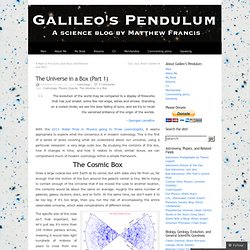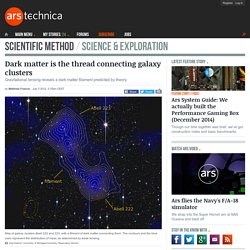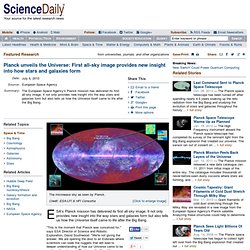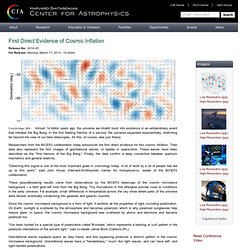

The Quantum and Cosmological Multiverses Merge Into One Bizarre Structure. The name of the image—the “Flammarion engraving”—may not ring a bell, but you’ve seen it many times.

It depicts a traveler wearing a cloak and clutching a walking-stick; behind him is a varied landscape of towns and trees; surrounding all is a crystalline shell fretted with countless stars. Reaching the edge of his world, the traveler pushes through to the other side and is dazzled by a whole new world of light and rainbows and fire.
The image was first published in 1888 in a book by French astronomer Camille Flammarion. (The original engraving was black and white, although colorized versions now abound.) One-Minute Physics: Are unknowns part of the universe? Sandrine Ceurstemont, editor, New Scientist TV.

Episode 1: The Shores Of The Cosmic Ocean (1/7) The Universe in a Box (Part 1) The evolution of the world may be compared to a display of fireworks that has just ended: some few red wisps, ashes and smoke.

Standing on a cooled cinder, we see the slow fading of suns, and we try to recall the vanished brilliance of the origin of the worlds.- Georges Lemaître With the 2011 Nobel Prize in Physics going to three cosmologists, it seems appropriate to explore what the consensus is in modern cosmology. This is the first of a series of posts covering what we understand about our universe, using a particular viewpoint: a very large cubic box.
By studying the contents of this box, how it changes in time, and how it relates to other, similar boxes, we can comprehend much of modern cosmology within a simple framework. 3D Map Of Universe: Galaxies, Black Holes Feature In Dazzling Sloan Digital Sky Survey VIDEO. Universe in a box: formation of large-scale structure. Dark matter is the thread connecting galaxy clusters. Simulations of the Universe on the largest scales show an unexpected resemblance to nerve cells in the human brain, with galaxy clusters playing the role of the cell body and thinner filaments of matter linking them like axons.

Galaxy surveys (such as the Sloan Digital Sky Survey, or SDSS) show that galaxies do cluster like our simulations predict. But the filaments that should connect them have been harder to find. Most of the mass in the Universe is dark matter—material that neither emits nor absorbs light—and filaments are predicted to be mostly dark matter: no galaxies, little hot gas. Einstein's general theory of relativity, however, tells us mass affects the path of light, and a group of astronomers have identified a dark matter filament by measuring this effect.
Jörg P. Planck unveils the Universe: First all-sky image provides new insight into how stars and galaxies form. ESA's Planck mission has delivered its first all-sky image.

It not only provides new insight into the way stars and galaxies form but also tells us how the Universe itself came to life after the Big Bang. "This is the moment that Planck was conceived for," says ESA Director of Science and Robotic Exploration, David Southwood. "We're not giving the answer. Holes in Space. Aug 21, 2008 Holes in Space In the gravitational model of the universe, "dark matter" attraction pulls galaxies into filaments.

Birkeland currents could be a better explanation. "Not only has no one ever found a void this big, but we never even expected to find one this size," said researcher Lawrence Rudnick of the University of Minnesota. Picture of the Big Bang (a.k.a. Oldest Light in the Universe) First Direct Evidence of Cosmic Inflation. Almost 14 billion years ago, the universe we inhabit burst into existence in an extraordinary event that initiated the Big Bang.

In the first fleeting fraction of a second, the universe expanded exponentially, stretching far beyond the view of our best telescopes. All this, of course, was just theory. Researchers from the BICEP2 collaboration today announced the first direct evidence for this cosmic inflation. Their data also represent the first images of gravitational waves, or ripples in space-time. Star Size Comparison HD. Gigapixels of Andromeda [4K] Photopic Sky Survey.
The Most Important Image Captured By Hubble. In 1996, scientists took a huge risk when they pointed the Hubble telescope to an inky field that they believed to be void of stars and planets.

As images from Hubble are in constant demand, the worry was that devoting so much time to a black space would prove futile. Once the photons finally registered, though, that leap of faith proved fruitful: light from over three thousand galaxies illuminated the image. A few years and missions later, Hubble’s glimpse into what is known as the deep field has revealed that we are just one tiny part of a vast system comprising 100 billion galaxies. Best astronomy images 2012: See the most beautiful images of the universe.
The Universe is beautiful.

Which is interesting. It doesn’t have to be; it could be all colorless and weird and lumpy. Instead, it’s bursting with color, sculpted by vast forces, molded into fantastic shapes that please our eyes and delight our brains—especially once we understand what we’re seeing. Every December I pick my favorite images from the previous year to display, a task that is extraordinarily difficult. I always wind up with a list of about 60 or 70, and I have to cull it down mercilessly. Many of these, you might expect, are from Hubble, but other telescopes get their share, as well as some that were taken by amateur astronomers with not much more than good cameras and a desire to see and capture the Universe.
I can’t argue with that sentiment. New Dimension: Nebulas Are Even More Amazing in 3-D. If the Moon Were Only 1 Pixel - A tediously accurate map of the solar system. Mercury Venus Earth You Are Here Moon Mars Jupiter. The Scale of the Universe 2. Radius of Observable Universe. The Most Astounding Fact (Neil deGrasse Tyson) Physicist Finds Out Why "We Are Stardust..." From universities, journals, and other organizations Date: June 25, 1999 Source: Louisiana State University Summary: When Joni Mitchell, in her song "Woodstock," sang, "We are stardust...

" she was being factual as well as poetic. When Joni Mitchell, in her song "Woodstock," sang, "We are stardust... " she was being factual as well as poetic. Story Source: The above story is based on materials provided by Louisiana State University. Cite This Page: Louisiana State University. Louisiana State University. (1999, June 25). Louisiana State University. 'Habitable' planet discovered circling Tau Ceti star. A planet with conditions that could support life orbits a twin neighbour of the sun visible to the naked eye, scientists have revealed.
The world is one of five thought to be circling Tau Ceti, a star just 12 light years away that is almost identical to the sun. Astronomers estimate the Tau Ceti planets to be two to six times bigger than Earth. One of them, with five times the Earth's mass, lies in the star's "habitable zone". Also known as the "Goldilocks zone", this is the orbital region that is neither too hot nor too cold to allow liquid surface water and, potentially, life. The Numbers Are Astronomical. A press conference today laid bare some new results from NASA's Kepler space telescope. They're astounding.
It turns out that about 22 percent of all Sun-like stars boast a planet that's at the right orbital distance to sustain liquid water on its surface. In other words, one in five of such stars has an Earth-size orbiting world in the so-called "habitable zone. " This result, announced by astronomers Erik Petigura, Andrew Howard, and Geoff Marcy (from the universities of California and Hawaii), significantly plumps the odds that there's life elsewhere in the cosmos.
Sean Carroll: Distant time and the hint of a multiverse.